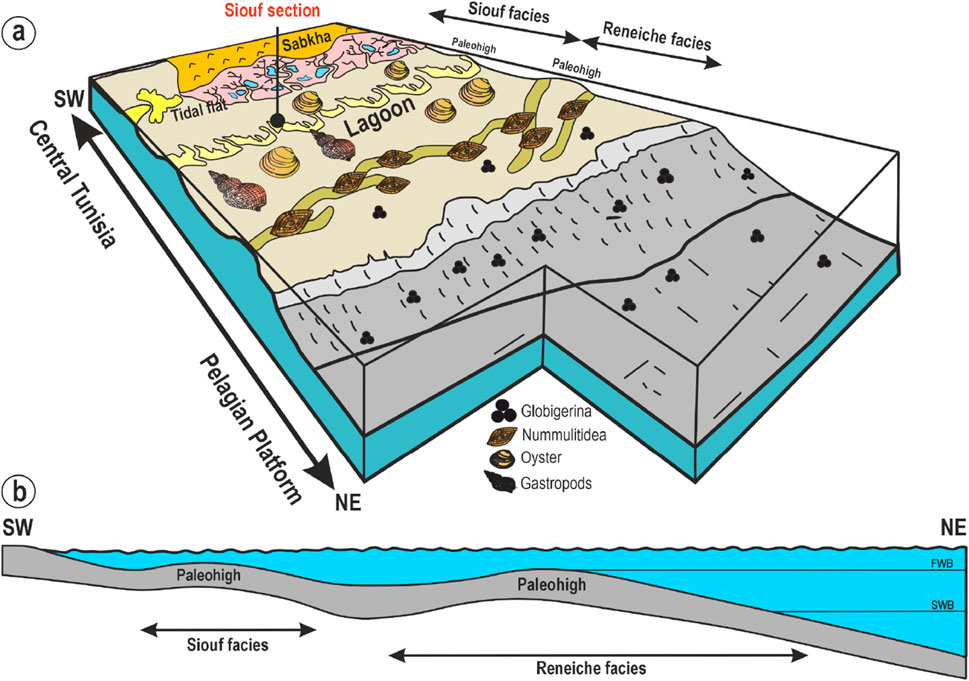- 1Ali I. Al-Naimi Petroleum Engineering Research Center, King Abdullah University of Science and Technology, Thuwal, Saudi Arabia
- 2Department of Geosciences and Natural Resource Management, University of Copenhagen, Copenhagen, Denmark
- 3Institute of Earth Sciences (ISTE), University of Lausanne, Lausanne, Switzerland
- 4Marine Geology Department, Faculty of Marine Sciences, King Abdulaziz University, Jeddah, Saudi Arabia
- 5Sfax National Engineering School, University of Sfax, Sfax, Tunisia
The Early Bartonian Reneiche/Siouf member is one of the primary conventional carbonate oil/gas reservoirs to be assessed in Tunisia that demands detailed evaluation. Accurate zonation and modeling of this reservoir require an integrated approach combining surface and subsurface studies. This research focuses on the depositional, diagenetic, and stratigraphic factors affecting reservoir quality and porosity within the Reneiche/Siouf member, utilizing an integrated surface-subsurface analysis. The primary aim is to understand the reservoir zonation of the Reineche Member near Kerkennah archipelago (eastern Tunisian offshore) and its lateral equivalents in central Tunisia the Siouf Member (outcrop analogue). Gamma-ray and sonic logs from the Reineche Member in the southern and southeastern Pelagian Platform (Tunisian offshore) identify three distinct limestone units (A, C, and E). These units transition into a single mud-dominated limestone unit (C) to the east and northeast of the Kerkennah archipelago. In contrast, the western Pelagian Platform (onshore) and Central Tunisia present a different stratigraphy for the Reineche/Siouf Member, comprising two limestone units: the Lower Reneiche Limestone (LRL) and the Upper Reneiche Limestone (URL), corresponding to Units C and E, respectively, separated by the Upper Reneiche Shale (URS) unit. Reservoir porosity and permeability analyses of the outcrop analogs reveal hybrid pore types (depositional and diagenetic), including intragranular, biomouldic, and vuggy pores, resulting from significant dissolution of large bioclasts. In the northern Gulf of Gabes, the Nummulite barrier of the Reineche Member (SW of the Kerkennah archipelago) demonstrates substantial reservoir quality improvement, with porosity reaching up to 30% in Unit C, attributed to intense dissolution, dolomitization (intercrystalline porosity), and fracturing. Diagenetic processes observed in the Siouf Member (Central Tunisia) differ from those in the Reineche Limestone Member (Pelagian Platform). In the Reineche Member, CO2-rich fluids entering through faults and fissures during deep burial diagenesis drive dissolution and dolomitization. Conversely, in the Siouf Member, these processes occur due to short subaerial exposures during meteoric to shallow-burial diagenesis. A key outcome of our study is the comparison between Central Tunisia and the eastern Tunisian offshore, highlighting local tectonic control on reservoir thickness and identifying three upward-thickening sequences in the Siouf Member outcrop. This research is crucial for understanding the Gulf of Gabes and Libyan offshore nummulitic Eocene reservoirs, emphasizing the role of tectonics and sea level changes in shaping reservoir characteristics.
Highlights
1.Large-scale variability in facies and depositional geometries drives reservoir heterogeneity.
2.Outcrop analog of the early Bartonian shows hybrid pores (depositional and diagenetic) with intragranular, biomoldic, and vuggy pores.
3.Burial versus meteoric models for vuggy/biomoldic porosity in the Pelagian platform and central Tunisia.
1 Introduction
Characterizing carbonate reservoirs is crucial for optimizing hydrocarbon extraction, carbon capture and storage, and enhancing geothermal energy development often found in carbonate formations. Thus, carbonate reservoir characterization is indispensable for sustainable hydrocarbon use, effective carbon sequestration, and efficient geothermal energy extraction, all of which are key to a resilient energy future (e.g., Guo et al., 2023; Liu et al., 2024, 2021; Raza et al., 2017; Rotelli et al., 2017; Singh et al., 2024; Wawerzinek et al., 2021; Wu and Li, 2020).
In the SW Neo-Tethys region, Eocene nummulitic limestone reservoirs extend from the western Pacific through the central Mediterranean to the Atlantic Ocean. These formations constitute significant hydrocarbon reservoirs in the northern African provinces (Bassi et al., 2013; Baz, 2019; Bey et al., 2015; Jorry, 2004; Racey et al., 2001). In central Tunisia and the Pelagian shelf, the seismic surveys conducted by Elf Aquitaine on the Gulf of Gabes (1965) and by Total in the Kairouan area (1968) provided information on the structural context of the early Eocene series showing Cretaceous grabens and progressively growing anticlines that took place during Cenozoic tectonic phases. At that time, exploration was related to the Paleocene and the early Eocene limestones (Ferjani et al., 1990; Mejri et al., 2009). The focus on the early Eocene Formations (El Garia and Boudabbous), due to their importance as oil reservoirs and source rocks, somewhat took away the attention from the middle-late Eocene Formations. Regionally extensive middle Eocene nummulite banks are called the Siouf Member, and its lateral equivalent, the Reineche Member, is sandwiched between the Lutetian and the upper Bartonian-Priabonian series. The Reineche/Siouf Member is encountered in numerous wells in central Tunisia and constitutes an oil reservoir in the Cercina field and a gas reservoir in the Chergui field (Gulf of Gabes, Ferjani et al., 1990; Mejri et al., 2009). The middle Eocene oil-producing province, which extends from central Tunisia to the north-western margin of the Sirt Basin (Libya), is considered the second most prolific Eocene carbonate play system after the nummulitic limestone of the early Eocene (Jorry, 2004; Racey et al., 2001; Sebei et al., 2007). The early Bartonian sea-level rise (Chouat et al., 2023; Messaoud et al., 2021; Messaoud et al., 2023; Messaoud et al., 2024; Miller et al., 2020) in Tunisia is manifested in the field by the widely extended transgressive deposit, the Siouf/Reineche Member, on different older series from the Kasserine Island to the Halk El Menzel platform. This transgression is also marked on the border of Kasserine Island and the Gafsa basin by the deposition of the Djebs evaporites (Burollet, 1956; Kadri et al., 2015).
Evaluating the rock properties of the early Bartonian carbonate reservoirs is challenging due to the scarcity of analogue studies of onshore carbonate outcrops in Tunisia. This limits our ability to model subsurface reservoir quality and develop analogue models based on surface observations for predicting carbonate facies and rock properties. This paper presents two case studies, one from an outcrop and one from the subsurface, both characterized by carbonate facies deposited in relatively shallow-water settings. These examples provide valuable insights into the primary controls on facies and petrophysical heterogeneity. The aim of this study is to offer insights into the primary controls on facies variability in these two shallow-water carbonate facies and the petrophysical heterogeneity in the subsurface case. Additionally, interpretations of depositional geometries and origin of porosity are presented, aiming to provide further insights into the depositional controls on reservoir quality and contribute to the development of more accurate predictive models. In details, this work aims to:
1.Outcrop analog analysis and facies distribution of Siouf Member in central Tunisia and correlation to the Pelagian platform (north Gulf of Gabes).
2.Homogenization of lithostratigraphic chart and depositional model for the early Bartonian deposits.
3.Detailed the lithostratigraphic correlation of the Reineche Member (using Gamma-Ray and Sonic) units in the Pelagian platform along transects, and reservoir layering.
2 Geological setting
Central Tunisia (Figure 1A). The Cherahil Formation (middle-upper Eocene) is widely developed in the central Tunisian basin. It consists of shallow-marine marl and lumachellic limestone with some highly dolomitized levels, passing during the early Bartonian into highly fossiliferous nummulite bioclastic limestone (Bey et al., 2015; Chouat et al., 2023; Hamdi and Lattrache, 2013). Rocks are principally carbonates and represent lagoonal facies in the lower part, evolving into more open-marine facies as pointed out by the abundance of benthic organisms (Jemia-Fakhfakh, 1991). The north Jebel Cherahil section (238 m) was logged and sampled for facies analysis (Figure 1), to show the general succession above and below the Siouf Member (Figure 2).
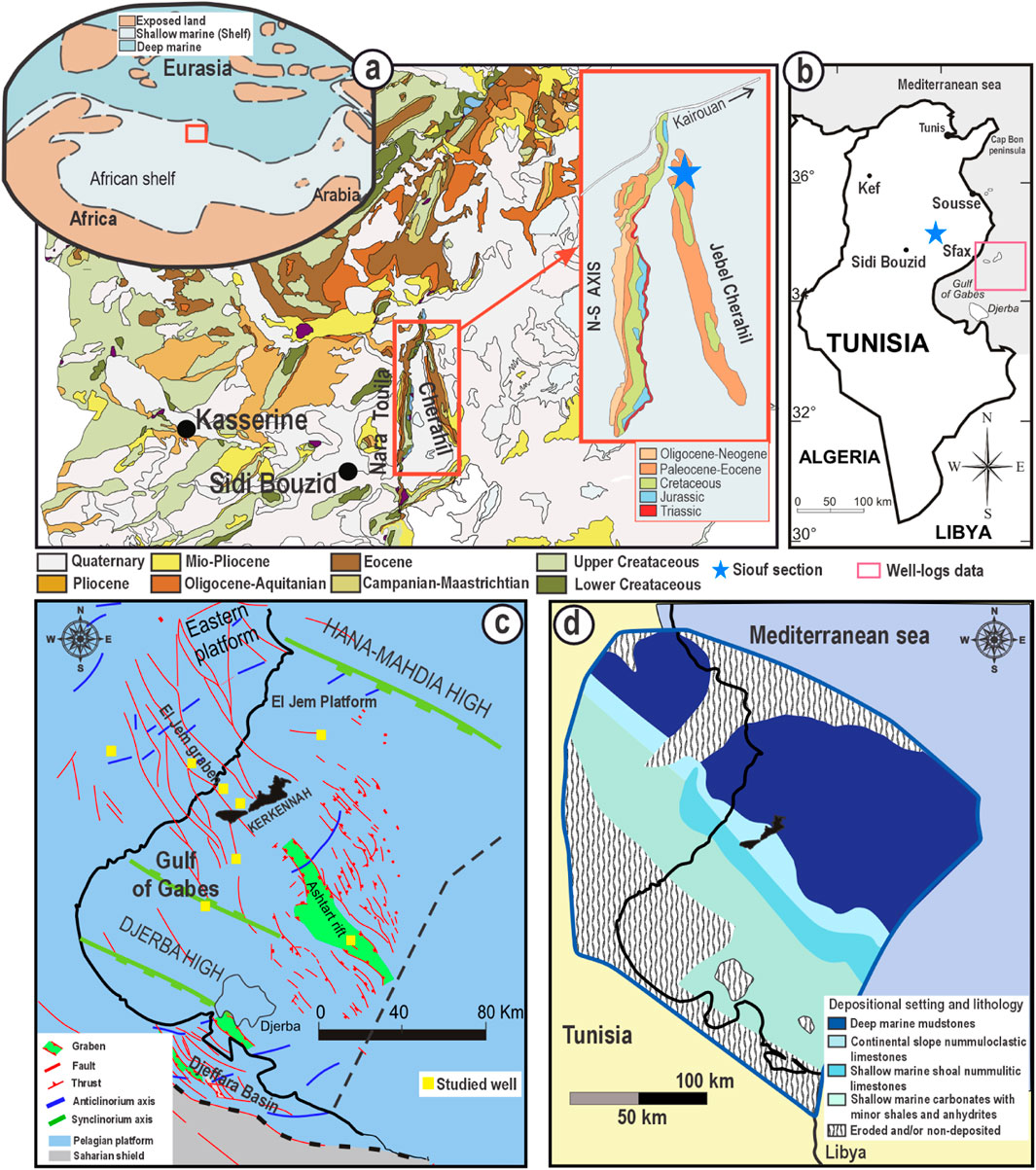
Figure 1. (A, B) shows the geographic location of the Siouf section with the geological map of central Tunisia (Kadri et al., 2015; Mansoura et al., 2005; Mejri et al., 2009). (C) Location of the studied wells. (D) The regional depositional trend of the Reineche/Siouf Member in eastern central Tunisia and the Gulf of Gabes (Göttlich et al., 2023).
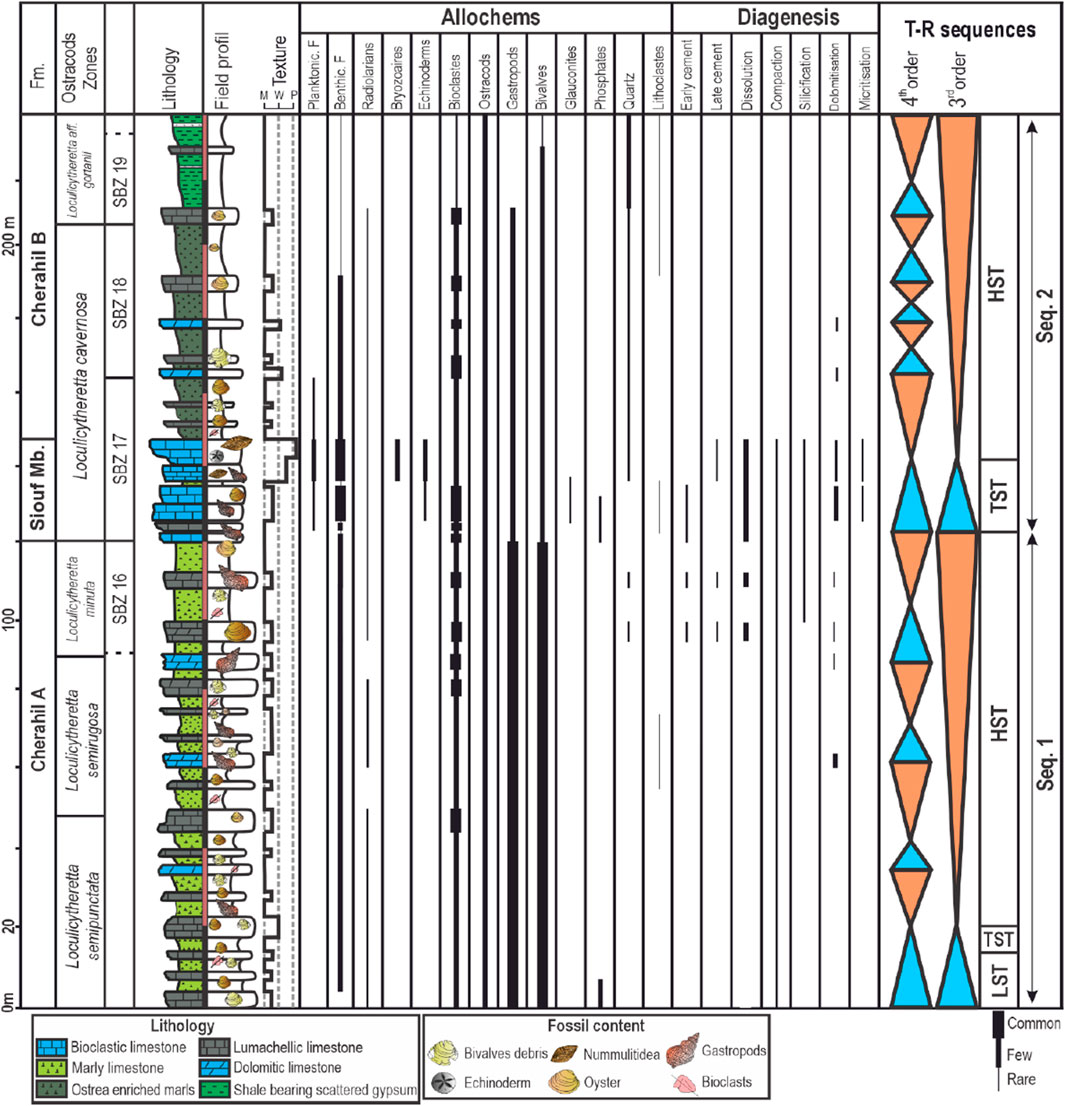
Figure 2. Vertical evolution of microfacies, diagenetic features, and the main sedimentological characteristics for the Siouf section. HST, high-stand systems tracts; TST, transgressive systems tracts. Major transgression occurs during the lower Bartonian.
Sfax offshore (Pelagian Platform, Figures 1C, D). The Pelagian province extends from eastern Tunisia onshore to the Maltese islands, where a vast fault zone known as the Misratah-Malta escarpment marks the eastern limit of this block. To the south, it is in contact with the cratonic block of Africa and with the Ragusa Plateau, part of Sicily to the north. Figure 1D shows the limits of the Pelagian Platform. The SW region of the Pelagian Platform is subdivided into four tectonic domains (the Gabes-Tripoli Basin, the Lampadusa-Medina Plateau, the Kerkennah Shoal, and the Jeffara-Djerba Shoal). The Gulf of Gabes is the subsident domain of the Pelagian platform. The Pelagian platform is structured in horsts and grabens with an NW-SE orientation parallel to the basin axis. This fault system led to the formation of a horst topography and grabens during the Mesozoic and Tertiary eras. These faults are often associated with other, less important, E-W-trending fault families. The Kerkenah archipelago is aligned in an NE-SW direction due to an NE-SW boundary fault. During the middle-upper Eocene, the Sfax offshore, including the Kerkenah archipelago, was lying within the Cherahil neritic shales and oyster-bearing limestone facies. Here, the Siouf Member (equivalent to the Reineche Member) includes several nodular limestones rich in bivalves and benthic foraminifera separated by several neritic shale units.
3 Materials and methods
3.1 Sedimentology
The Siouf Member was carefully sampled/logged (36 samples) at a 1 m resolution at Jebel Siouf (Figure 1). The stratigraphic analysis includes tracking depositional units, facies types assessment, and fossils content. The definition of facies is based on a detailed field analysis of the depositional features: fossil content, texture, sedimentary structures, the abundance of carbonate grains (mainly skeletal grains), the character of bounding surfaces, and thickness. Also, each macro-facies was supplemented by observations of at least one thin section. The limestone microfacies were described following the Dunham (1962) classification. Petrographic observations were made on thin sections using an optical microscope (natural light, crossed polarized light, and cross-polarized light coupled with gypsum plate) to determine depositional fabrics, principal grain type, and diagenetic fabrics, which are used to interpret the diagenetic history and resulting pore network.
3.2 Well logging data
Gamma-ray (GR) and sonic were used to make subdivisions and correlations within the Reineche interval. Correlations were performed using the Schlumberger Petrel software. The detailed description of the outcrop analog sections in central Tunisia (Siouf Member) and NE Tunisia (Cap Bon, Reineche Member) guided the definition of facies and the significant lithological changes for calibrating the GR signatures. Well-log data petrophysical analysis and correlation are used for the reservoir characterization (using the Petrel software). Reservoir subdivisions/layering are defined using GR and Sonic (DT).
4 Results
4.1 Lithostratigraphy of the middle-upper Eocene in central Tunisia
When the percentage of limestone and coquina (oysters) exceeds 50% in Central Tunisia and NE Gulf of Gabes, the middle–upper Eocene deposits are attributed to the Cherahil Formation to distinguish it from the globigerinid-rich shales of the Souar Formation (N and NE Tunisia). The fieldwork assessment of the Cherahil Formation at the northern Jebel Cherahil (Central Tunisia) reveals distinct lithostratigraphic successions characterized by variations in bedding, weathering profile, and lithology. The Fejij section is predominantly composed of limestone, forming prominent high cliffs with clear cyclic stratigraphic patterns in bedding and lithology.
The Cherahil A unit starts with lumachellic limestone, marly limestone, and bioclastic mudstone/wackestone. The Lutetian cycles exhibit a meters-scale, 2–4 m cyclicity of marls and limestone alternations (about 60 alternations) with well-preserved oyster shells. We use the term lumachellic limestone to define oyster shell levels found in life positions in a matrix of fine carbonate. The observed mono-specific marine fossils are favored in a restricted environment with low detrital inputs. Microscopic analysis showed mudstone textures comprising scare ostracods (Bairdia sp. and Protobuntonia sp.), and rare benthic foraminifera (Lenticulina). The muddy matrix and the preservation of the oysters in mass and life position suggest no transport and deposition in protected environments of low-energy conditions such as a restricted bay (lagoon, Jorry, 2004) during the Lutetian. The uppermost Lutetian shows a sharp surface marked by greenish silty marl with fine grains of quartz (Figure 2).
The general vertical stacking points towards shallowing upward sequences interrupted during the early Bartonian by thick bioclastic limestone beds (24 m) of the Reineche/Siouf Member (details in paragraph 3.2).
The Cherahil B unit corresponds to thin (1.5–2 m) beds of tightly packed bivalves (oysters and gastropods) of various sizes within a carbonate mudstone matrix separated by thicker (3 m) marly to shale beds. The upper Cherahil B unit lacks skeletal grains with abundant silt fraction in the shales (Figure 2).
4.2 Facies description of the Siouf Member in central Tunisia
Three sequences were identified in the Siouf Member (Figure 3). Each sequence begins with muddy facies, which are lumachellic in sequences 1 and 2, transitioning to more grain-supported facies at the top. The thickness of these sequences increases progressively from sequence 1 to sequence 3, with sequence 3 reaching a thickness of 11 m compared to the 5 m of sequence 1 (Figure 3). Five standard facies were defined, distinguished primarily by their macrofossil and microfossil content, texture, and observed sedimentary structures (Table 1).
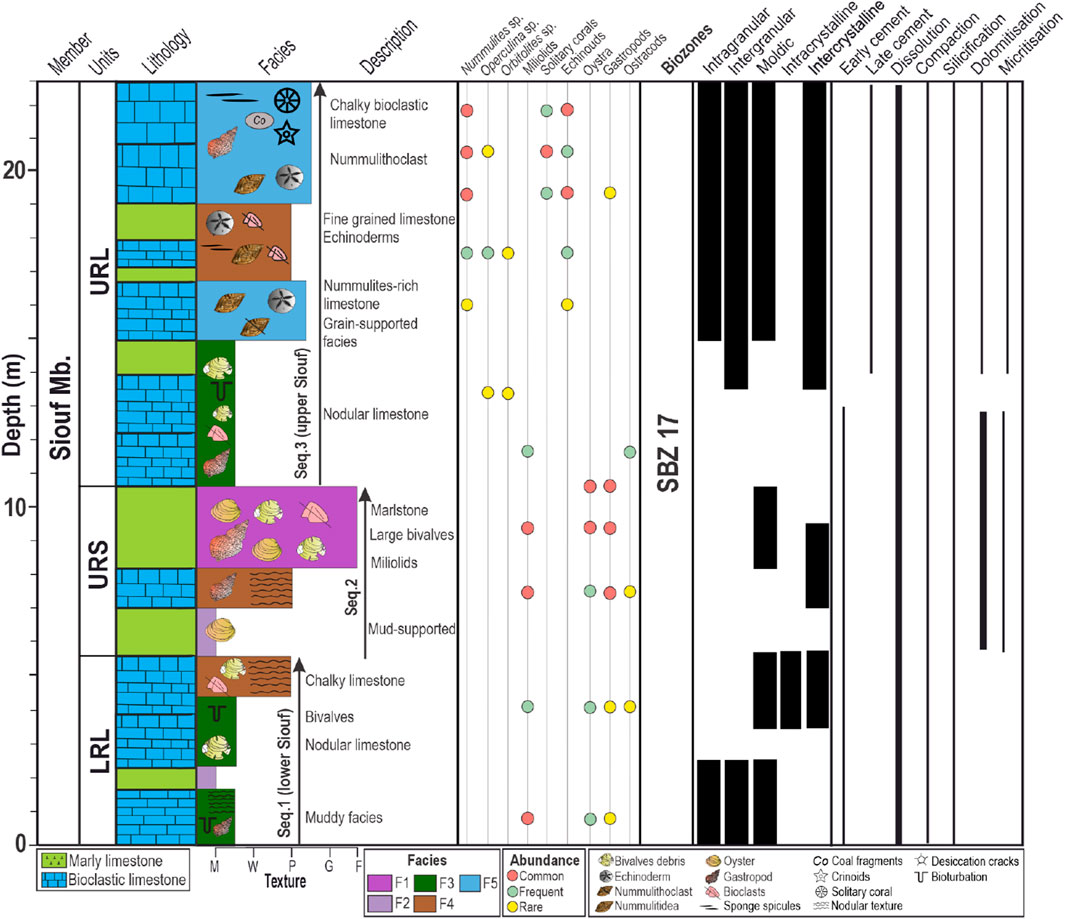
Figure 3. Detailed sedimentological information (fauna content, sequences, type of porosity, and diagenetic features) was observed in the Siouf Member at Jebel Siouf.
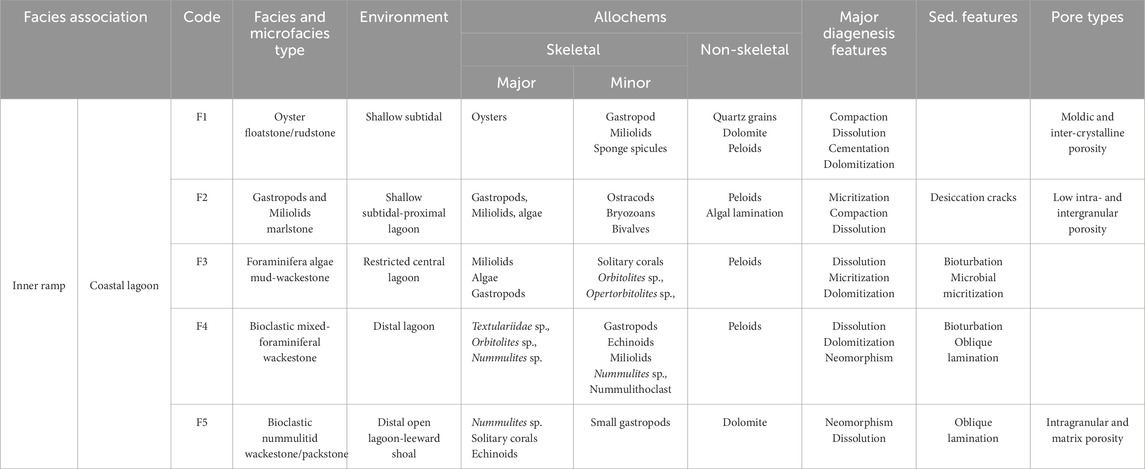
Table 1. Dominant components of the distinguished facies along with the facies interpretation. The dominance of lumachellic limestone distinguishes the proximal inner ramp, and the distal inner ramp (subtidal) is distinguished by the dominance of LBF and the frequent PF.
4.2.1 Facies F1: oyster floatstone/rudstone
Fossiliferous limestone (floatstone/rudstone) with recrystallized oyster shell fragments floating in the micritic matrix. Mouldic porosity is visible in the field and on thin sections. Shell fragments are reworked, attesting for sediment transport. Major components include oysters, gastropods, and benthic forams (miliolids). The shell fragments are recrystallized with dolomite rhombs and intense leaching of shell debris (moldic porosity). The main diagenetic features are the severe dissolution of oysters and the early dolomitization (Figure 3).
4.2.2 Facies F2: gastropods and miliolids marlstone
Nodular marlstone with abundant gastropods and miliolids in a micritic matrix. The texture is wackestone to packstone. Gastropods, bivalves, and other shell fragments are recrystallized. F2 is common in the Lutetian and is limited to the lower Siouf (eq. Lower Reineche Limestone). F2 depositional environment corresponds to a restricted environment within the inner lagoon.
4.2.3 Facies F3: foraminifera algae wackestone
Mud-supported facies are dominated by coralline algae (rhodolites). The occurrence of miliolids, gastropods, calcareous green algae, and other frequent skeletal fragments such as Orbitolites sp., Opertorbitolites douvillei, bivalves, small rotalida, and characterizes F3. Microbial micritization, intense moldic porosity, and calcite cementation/replacement are the most important diagenetic processes. Calcite sparry cement fills fractures, intergranular, and intragranular pores.
4.2.4 Facies F4: bioclastic mixed-foraminiferal wackestone/packstone
Fine-grain bioclastic facies contain significant foraminifers with rare bivalves and gastropods. Orbitolites dominate the assemblage in high-energy, large-scale oblique bedding structures (Figure 4). These allochems are well preserved, and their chambers are filled with calcite. The micritic matrix contains nummulithoclasts and calcite. F4 occurs at the upper LRL Member and is described as chalky and bivalve-bearing bioclastic limestone. The microcrystalline calcite cement and occurrence of nummulithoclasts advocate for a distal lagoon. The diagenetic processes observed include dolomitization, micritization, and aggrading neomorphism. The cementation occurs with spar and microspar precipitation in the porous cavities (Figure 5).
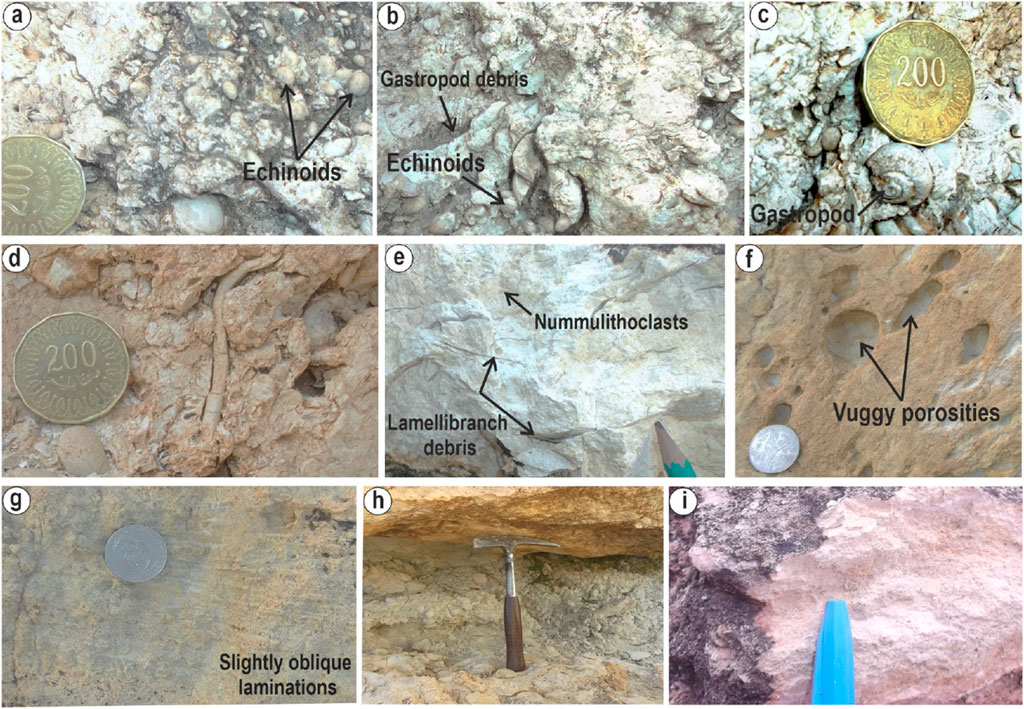
Figure 4. Field photographs of the Siouf Member. (A) Small-sized echinoderms (Echinolampas, (Jorry, 2004) of facies F5-B (the coin is 2.9 cm for scale). (B, C) are field views showing fossil associations (small gastropods, nummulites, and echinoderms) observed in facies F5-A (upper Siouf Member). (D) Crinoid within facies F5-B. The coin is 2.9 cm in diameter. (E) Lamellibranch debris was observed in facies F4 (upper lower Siouf Member). (F) Vuggy porosities with the nummulithoclasts were observed in facies F5-B (the coin is 2.9 cm in diameter). (G) Low-angle parallel lamination observed in facies F4. (H) Field view at the base of the Siouf Member (hammer 30 cm for scale). (I) Rich nummulithoclasts accumulation of facies F5-B (the pen is 5 cm long).
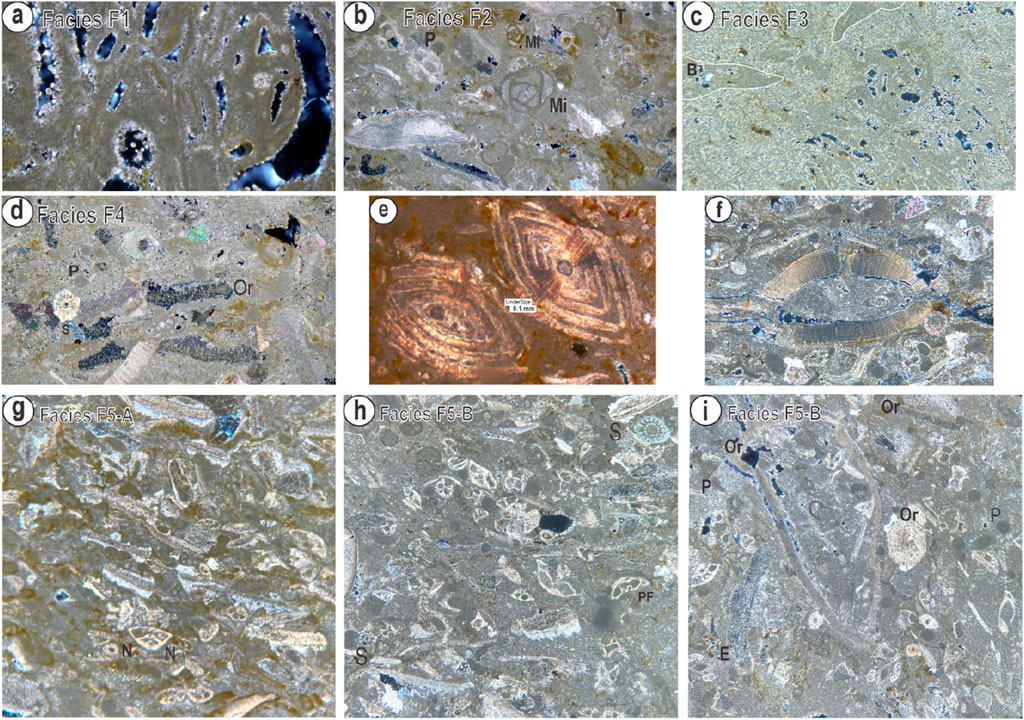
Figure 5. Photomicrographs of thin sections illustrate the identified macro-facies. (A) Represent the rudstone of F1 with a dense micritic matrix, intense dissolution of the bioclasts (oysters), and minor dolomitization of the micritic part of the matrix. (B) Wackestone with bivalve shell debris, miliolids, ostracods, and other benthic forams within a micritic matrix, with peloids (P) and micritization of the bioclasts edges. (C) Bioturbated mud- to wackestone of F3 with rare bioclasts. The matrix is micritized with dolomite crystals. (D) Wackestone texture of F4 with common echinoid spines and Orbitolites sp. Dissolution affects the debris of bivalves and to a lesser degree, the matrix (micritized). (E) Scaphopod. SM-15. The detail of a transversal section in a scaphopod tube filled with dissolved micritic matrix (intergranular porosity). The structure is composed of a thick external calcitic layer and an internal micritic layer. (F) Nummulites sp., SM-18. (G) Wacke- to packstone of F5-A with Nummulites sp., Orbitolites sp., and rare bivalve/gastropods debris. The dense micritic matrix shows scarce dissolution and dolomite. (H, I) Wacke- to packstone of F5-B with more (compared to F5-A) nummulites and nummulithoclasts content. Orbitolites sp., solitary corals, and planktonic foraminifera are rare.
4.2.5 Facies F5: bioclastic nummulitid wackestone/packstone
These facies are characterized by the dominance of solitary corals (more than F4). The Upper part of the URL unit shows a chalky limestone with rare nummulites, echinoids, small gastropods, and solitary coral fragments (Figure 4D). The microfacies predominantly comprise wackestones and packstones with a subordinate occurrence of grainstone. Small benthic foraminifera and bioclasts are the primary constituents. F5 can be subdivided into two microfacies based on the faunal association and texture.
The first microfacies, F5-A, is a bioclastic wackestone (Figure 5G), composed of rare Operculina sp., Nummulites sp., (Figure 5E), small gastropods, echinoids, and sponge spicule. Miliolids are rare with small gastropods and red algae in low density.
The second micro facies, F5-B, is a bioclast nummulitid packstone (Figures 5H, I), with an increased volume of nummulithoclasts and biota comprising Nummulites sp., solitary corals, and echinoids. F5-B has better sorting than F5-A. The observed hummocky cross-stratification could generate the low-angle parallel lamination (Figure 4G) previously observed in the Reineche Member by Bey et al. (2015). Microscopic analysis showed rare planktonic foraminifera (Subbotina corpulenta and Acarinina topilensis). The top of this facies within the Siouf Member shows green algae (dasycladales). The lack of mud within the matrix and the abundance of nummulithoclasts (Figure 5I) point to a relatively more open marine environment. The rich benthic fauna and the occurrence of Lenticulina advocate a distal lagoon to a leeward shoal environment. The fragmented tests of the identified foraminifera are filled with crystalline calcite. The diagenetic processes observed include dolomitization, fracturing, micritization, neomorphism, and replacement. The cementation of the matrix by calcite or micrite.
4.3 Subsurface Reineche Member in the eastern Tunisian offshore
In the Pelagian Platform, the Souar Formation of the Lutetian-Priabonian age is up to 800 m thick and is a lateral equivalent of the Cherahil Formation. It is subdivided into two members. A lower member called Souar A. It is clayey with intercalations of fine limestone, sometimes dolomitic, and marly intercalations. The upper limb is known as Souar B. It consists of gray to green clayey layers interspersed with shell and sometimes gypsum levels. These two members are separated by a carbonate nummulite reference level corresponding to the Reineche Member. The Cherahil Formation is the southern lateral equivalent of the Souar Formation. It is also subdivided into two members, between which we always find the nummulites marker of the Reineche/Siouf Member, which constitutes a reservoir level.
The lower member is called Cherahil A, and consists of alternating bioclastic limestones, locally sandstone and/or dolomitic and green clays. The upper member or Cherahil B comprises alternating greenish, grey, laminated clays and limestones that are sometimes lumachellic, beige, whitish, hard, chalky and soft.
In contrast to its lateral equivalent (Siouf Member), which contains faunas indicative of confined depositional environments, the Reineche carbonate Member in Sfax offshore is distinguished by the occurrence of numerous nummulites. Stratigraphic and sedimentological research, together with E-log interpretations, led to the identification of three different units from top to bottom: Upper Reineche limestone unit (URL), Middle Reineche shale (URS) unit, and Lower Reineche limestone (LRL) unit.
The Reineche member is recognized in all the wells drilled in Sfax onshore and offshore, with thicknesses ranging from 30 to 70 m. The Reineche member in this area generally consists of three carbonate bars, the median of which, with nummulites, has very high porosity and permeability. The other two bars are beige, chalky, and bioclastic limestones.
In the Cercina field and Ashtart region, the Reineche Member is represented by Nummulite limestones represented by Nummulites limestones associated with Ostracodes, Bolivines, Echinoid debris, Algae, and Bryozoans, with the presence of a few planktonic Foraminifera. Integration of lithofacies and logging data from seven wells in the Gulf of Gabes and 18 additional wells near the research region was necessary for the lithostratigraphic subdivision of the Reineche Member. Well-01 (SE Kerkenah Island) was the reference well for these subdivisions. A complete series distinguishes it.
The GR and sonic curves have enabled us to subdivide the Reineche Member into five units, each corresponding to a distinct lithological member (Figures 6, 7). From bottom to top, these are:
1.Bioclastic limestones with bivalves, echinoids, and benthic foraminifera, particularly Nummulites, characterize Unit A with a thickness of around 23 m. This unit is characterized by low gamma ray values and medium sonic value.
2.Ostracod clays, striated Bolivines, and Nummulites represent unit B. This unit is characterized by a thickness of around 6 m in the ASHA borehole. The transition from unit A to unit B is marked by a significant shift on the GR curve and a crossover of the two curves, with an increase in sonic values.
3.Unit C consists of nummulites, limestones, and bioclasts that are 16 m thick. It forms the reservoir of the Cercina and Chergui fields. The GR and sonic of this unit are obvious, characterized by a sharp decrease in GR and sonic values. This unit can be subdivided into two sub-units. Clayey limestones with Nummulites and bioclasts with a thickness of 7 m from the lower C1 sub-unit. Nummulites and nummulithoclasts with Bivalve debris, echinoids, algae, bryozoans, ostracods, and benthic foraminifera represent the upper C2 term. This sub-unit is 9 m thick.
4.Unit D is a Nummulites and ostracods clay. It is 16 m thick. The GR and sonic curves are characterized by a significant shift and crossover of the two curves.
5.Bioclastic limestones with bivalves, gastropods, and bryozoans form unit E (around 11 m thick) at the top of the Reineche. It is characterized by low GR and sonic values.

Figure 6. Units of the Reineche member in the Pelagian platform were identified based on the GR and Sonic signals in Well-01.
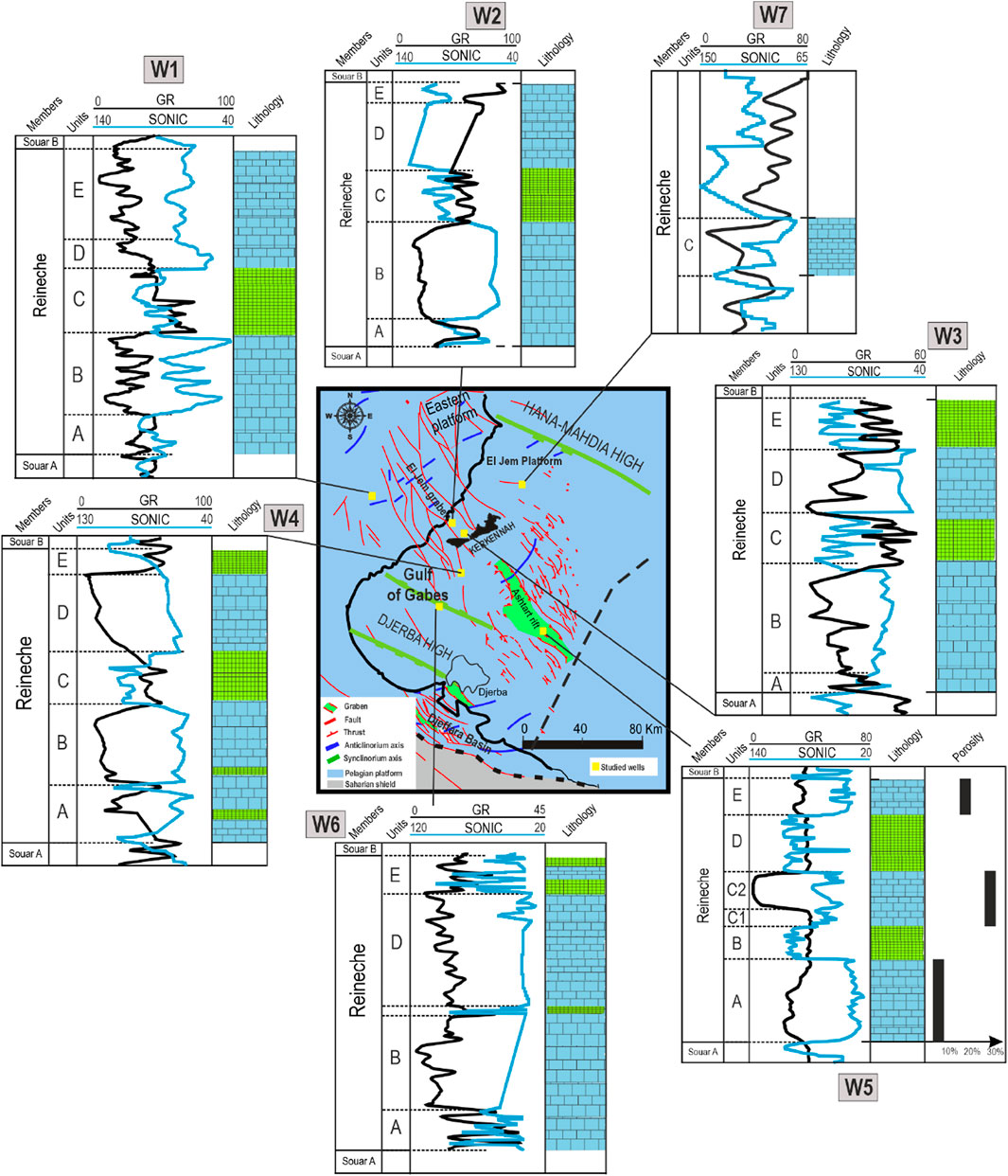
Figure 7. The GR and sonic data of the Reineche/Siouf Member in eastern Tunisia (onshore and offshore) in seven locations.
4.4 Diagenesis/porosity assessment of the outcrop
The textures of the Siouf Member are dominated by wackestone to packstone, and the interparticle space is filled with micritized carbonate mudstone. The neomorphic replacement of the molluscan bioclasts is the main diagenetic process..
Micritization is reported in the packstone and wackestone facies’ skeletal fabric and the packstone facies’ non-skeletal allochems (pelletoids). Micritization occurs inside these microfacies as a micritic envelope surrounding the peripheries of algae, pelletoids, benthic foraminifera, and certain bioclasts (Figure 5A). The micritization process occurs at the water-sediment interface, defining an early stage of eogenesis..
1.Dolomitization occurs in the proximal facies (F1 and F2), synchronous to the occurrence of restricted fauna (Orbitolites, oysters, and Milolids) and bioturbated wackestone. Nummulite shells are also dolomitized (facies F5). Dolomite crystals are mostly found as scattered small (silt-size) rhomboedric crystals within the matrix (Figures 8A, D) or within fractures (F1 to F3).
2.The nummulitic limestone in the Pelagian shelf has moldic to vuggy porosity of 20%–30%. This inter- and intragranular porosity ranges from 8% to 9% in the URS. The intragranular porosity alone in the URL surpasses 15%. In the URS and URL, nummulitoclastic pack-to-grainstone facies have a porosity of up to 30% in dolomite and up to 15% in limestone (Figure 6).
3.Cementation: In the fossiliferous carbonates, the blocky fine to coarse-grained cement of 0.3–2 mm size range fills the intraparticle and vuggy porosities (Figure 8F). Granular cement (30–50 um) appeared as intraparticle cement in the inside cavities of the bioclasts in the mud- to wackestone facies (Figure 8), and in the interparticle pores (Figure 8E). In the outcrop, drusy cement fills the biomouldic holes of the dissolved bivalves and gastropods. Crystal size grows toward the pore center (Figures 8D, F).
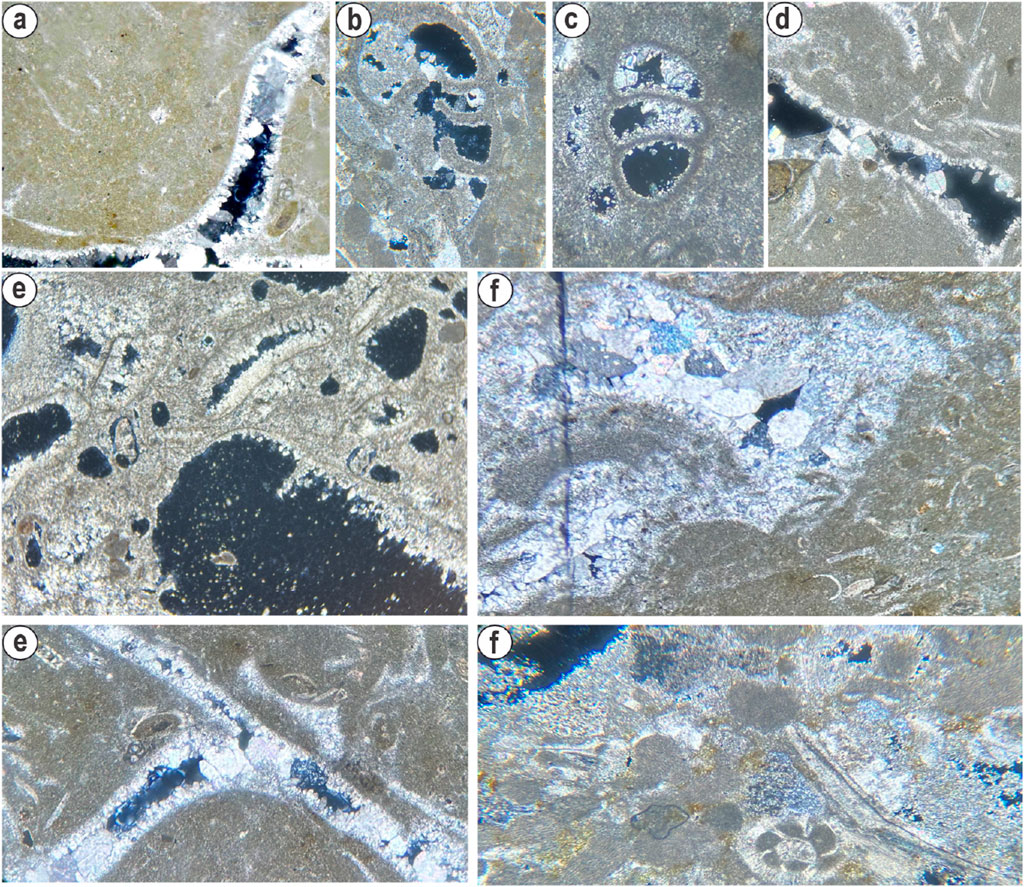
Figure 8. (A) F4 is crossed by fractures partially filled by burial calcite spar. (B, C) are examples of intragranular calcite spar cements in F2 and F3, respectively. Some smaller crystals lining bioclast rims have scalenohedral terminations. The intragranular zooid pores are filled with brown micrite (B), but the micrite has recrystallized to calcite spar. In some crystals, boundaries are less distinct because the neomorphic spar is intergrown with remnant micrite. (D) A mix of cavity-filling cement fabrics in coarse calcite spar and neomorphic textures. Crystal boundaries are planar, and terminations are sharp. Some of the crystals have developed incipient neomorphism. Fracture/biomouldic porosity is reduced by calcite spar during the burial cementation phase. (E, F) shows the intense leaching of shell debris within F1 (mouldic porosity) and the partial dolomitization of the micritic matrix. There is a gradation in crystal size from small crystals lining the cavity wall to much coarser spar in the cavity interior.
5 Discussion
5.1 Facies interpretation of the Siouf Member in central Tunisia
A petrographic study of rocks from the Siouf Member outcrop reveals an inner ramp setting with a restricted lagoon for facies F1 to F3, less restricted lagoon for F4, and open lagoon for F5 A and B settings. Oyster wackestone/rudstone facies of F1 with abundant oysters and gastropods and low diversity of organisms, presence of miliolids, and abundant micritic matrix indicate low-energy near-shore shallow subtidal to intertidal with reworking and transportation under the effect of tidal currents or channels. The gastropods and miliolids marlstone facies (F2) implies a sheltered shallow platform habitat with minimal water circulation and turbulence and a soft substrate in a euphotic zone where temperature and salinity changes are significant, resulting in a harsh habitat dominated by gastropods. Green algae, with restricted marine fauna (miliolids and gastropods) scattered in an abundant mud and micritized matrix (F3), suggests a low-energy environment with restricted circulation. The scattered debris of solitary corals is related to a relatively more open marine setting than F2.
Facies F4 (Bioclastic mixed-foraminiferal wackestone/packstone) show more dynamic environments than the preceding microfacies due to the various bioclasts and relatively scarce levels of micrite. Rare nummulites and nummulithoclasts with Orbitolites sp. are observed. The absence of gastropods and oysters in F4 points to a more distal setting. The micritized skeletal pieces in the micritic texture indicate a sheltered distal shallow water lagoon context with significant microbial activity. The bioclastic nummulitid wackestone/packstone (F5 A and B) are thick-bedded, containing rich fauna (nummulites, solitary corals, bivalves, echinoderms, and small gastropods). The abundance and high diversity of skeletal fauna distinguish these facies from the restricted lagoon facies of the lower Siouf Member units. The packstone texture indicates a depositional environment with high hydrodynamic energy (Dunham, 1962; Flugel and Flügel, 2004). The association of echinoderms, benthic foraminifera, solitary corals, and nummulites indicates a more open water circulation within the lagoonal settings (Njahi et al., 2017). This fauna association occurrence is favored in well-oxygenated waters. The texture and fossil content of F5 indicate a low-relief carbonate bank (barrier beach).
5.2 Deposition model and impact of local tectonics
In the shallow carbonate platform of central Tunisia, Ben-Ismail-Lattrache, (2000) studied the Siouf limestone member in central Tunisia (Jebel Jebil). They reported only a 5 m thick limestone series rich in LBF: Nummulites gizehensis, Discocyclina roberti, Discocyclina sella, Operculina spp., and Alveolina spp. In Jebel Serj (northern central Tunisia), the same member is only 40 cm thick (Hamdi and Lattrache, 2013) admitting Nummulites and Alveolina elongata in addition to bryozoans, echinoderms, lamellibranchs (Ostrea lamellosa), and algae.
In the Bargou area (northern central Tunisia), the Reineche/Siouf member is identified by a micritic argillaceous limestone bed (30 cm thick) rich in iron oxide, phosphate, and glauconite. The fauna association is represented by BF (Peneroplis, Buliminides genera, Bolivina spp., Subbotina kamali, and Nummulites gizehensis) and PF characteristic of the Orbulinoides beckmanni zone (E13, lower Bartonian). In southern central Tunisia (Ben-Ismail-Lattrache, 2000), this member becomes very dolomitic, and bioclastic, and contains iron oxide concretions indicating an upper intertidal depositional environment (Matmati et al., 1992).
The Reineche/Siouf member extends in the subsurface over the southern Pelagian margin, where it is proven a producing reservoir and reappears in the Cap-Bon and locally in the northern Tunisian Atlas (Mejri et al., 2009; Taktak et al., 2012). The trend is superimposed along the edge of the early Eocene transitional area and can be traced as a narrow belt that took place over a gentle homoclinal ramp (Elfessi, 2017; Ferjani et al., 1990). The preferential nummulitic carbonate production in central Tunisia during the early Bartonian is mainly related to the structuration of continental shelves and the isolated platforms during the middle Eocene (Jorry, 2004). Enhanced syn-sedimentary tectonic control in central Tunisia and the Pelagian platform explains the high variations in thickness and nummulites content of this limestone member (Bonnefous and Bismuth, 1982; Khomsi et al., 2006).
The sedimentation patterns and internal facies zonation were influenced by sea level fluctuations and the topographic irregularities of the sea floor, which were shaped by Jurassic and Cretaceous tectonics (Mejri et al., 2009; Taktak et al., 2012). Ecological, biological, and physical factors significantly impacted the distribution and geometry of the nummulitic bodies (Jorry, 2004). In the eastern Tunisian offshore, a carbonate bank developed on a sea floor characterized by a tectonic high adjacent to a depression or graben where nummulites accumulated. The Reneiche/Siouf Member thins out towards Jebel Zaghouan, where it pinches out, and then reappears in the Cap Bon Peninsula (Chouat et al., 2023; Messaoud et al., 2021; 2023; 2024).
A complex low-angle homoclinal ramp depositional model with lagoons and low-relief carbonate banks is proposed for the Reineche/Siouf member in central Tunisia and Sfax offshore. This profile features three zones: the inner platform, the Nummulites barrier, and the outer platform. For the transect from Jebel Siouf (central Tunisia) to the Sfax offshore (SW-NE, Figure 10), the depositional model begins in the emerged area in the south and southwest (Figures 9, 10). To the east, it transitions into a widespread shelf domain that deepens towards the east and northeast. This profile features a complex ramp system with a back bank system, characterized by dominant oysters, gastropods, miliolids, and small-nummulites of the Siouf Member, followed by elongated, low-relief carbonate banks with large nummulites facies of the Reineche member, trending NW-SE.
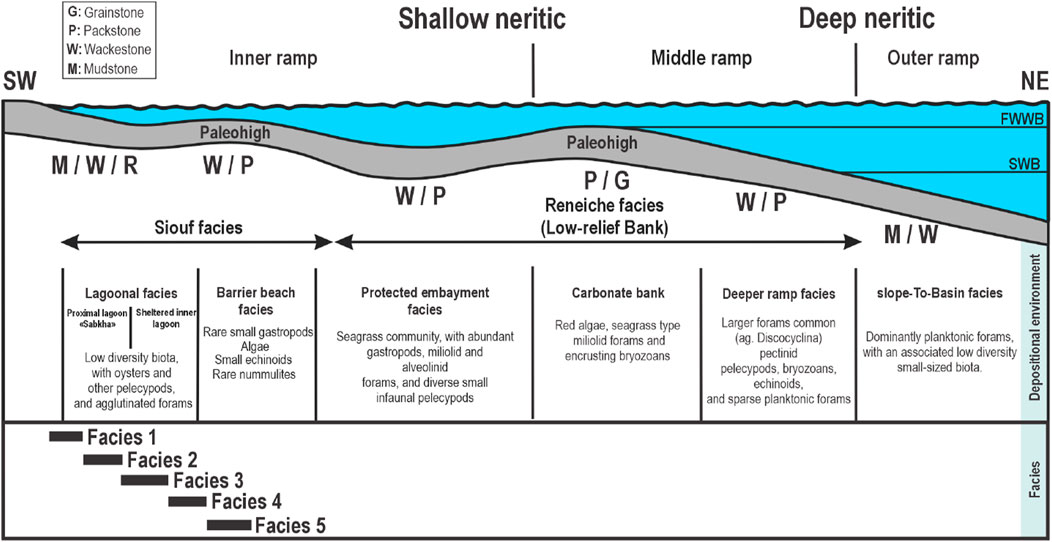
Figure 9. An SW-NE trending schematic cross-sections across central Tunisia and Pelagian platform showing a complex ramp with restricted lagoons and carbonate banks during the early Bartonian with the distribution of the Siouf Member facies.
5.3 SW Neo-Tethys nummulitic carbonate reservoirs
The establishment of the nummulitic limestone during the early Bartonian reflects the presence of ancient warm water (e.g., Bassi et al., 2013; Tomassetti et al., 2016). Here, we attribute the Middle Eocene “maximum” marine carbonate production event materialized in central Tunisia by the Reineche/Siouf member as a response to the Middle Eocene Climatic Optimum (Messaoud et al. (2024); Figure 11). The coincidence of this sedimentological shift with geochemical and biological (apparitions, disappearances, and the proliferation of specific taxa) events may be due to environmental changes. These results are very similar to those recorded during the Early Eocene Climatic Optimum (EECO), which coincides with the deposition of the Ypresian nummulitic limestones of the El Garia Formation in the same marginal setting of the Neo-Tethys (Racey et al., 2001; Taktak et al., 2010; Tlig et al., 2010).
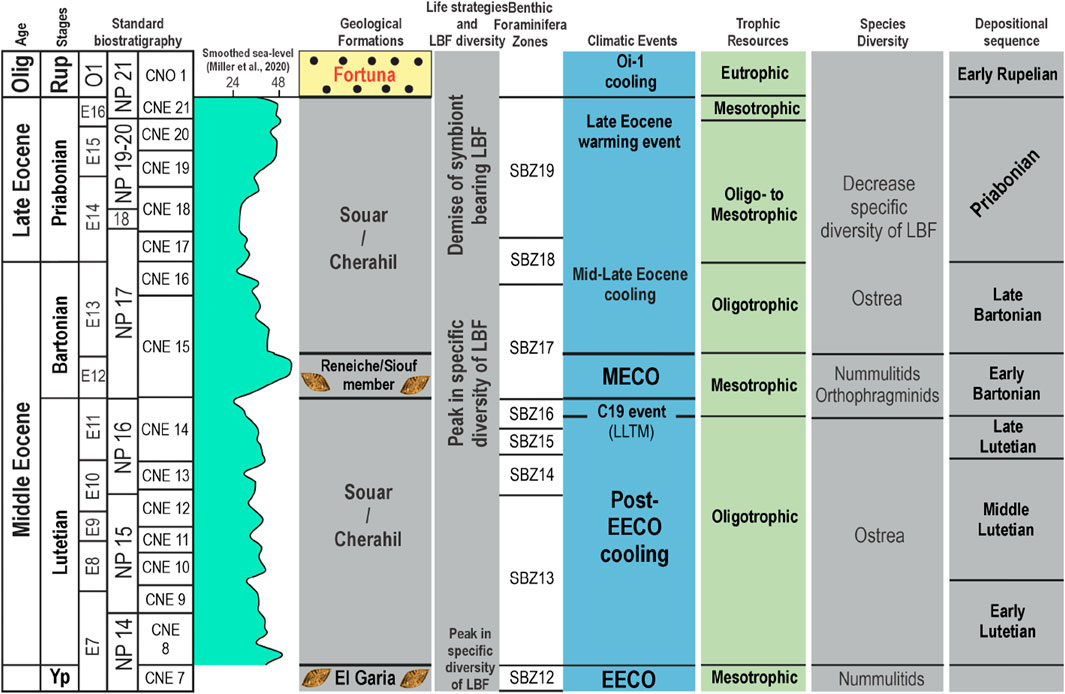
Figure 11. Ypresian to Priabonian biostratigraphy, geological Formation, shallow benthic zones, climatic events and trophic resources and benthic species diversity.
These nummulitic limestone reservoirs of the SW Neo-Tethys were developed under a warm climate (Brasier, 1995; Jorry, 2004; Messaoud et al., 2023) with high sedimentation rates (up to >100 m/m.y.), and abundant large BF association dominated by nummulites (Bassi et al., 2013; Baz, 2019; Jorry, 2004). Eocene nummulitic limestones series constitute an important hydrocarbon reservoir in the northern and northeast African provinces (Bey et al., 2015; Jorry, 2004; Racey et al., 2001; Swei and Tucker, 2015; Taktak et al., 2012; 2010).
Scheibner and Speijer (2009), Höntzsch (2011), and Höntzsch et al. (2013) show that global warming during the Early Paleogene caused a massive decline in coral reefs and a coeval shift to large benthic foraminifera (LBF). A transient period with an increasing abundance of LBF K-strategist taxa is also present during the MECO (Bassi et al., 2013; Höntzsch, 2011). During the Late Eocene (Figure 11), the general cooling trend (Late Eocene cooling event) caused the extinction of LBF (e.g., discocyclinids; early Paleogene Nummulites;Prothero et al., 2003).
5.4 Reservoir zonation in the eastern Tunisian offshore
The analysis of the Reineche reservoir is based on data from seven wells. We partitioned the reservoir using logging data into various units with distinct lithologies, GR/Sonic, and petrophysical properties (Figure 12). Each well was divided into multiple units, and we correlated the boreholes by tracking lateral changes in thickness and facies for each unit. To maintain confidentiality, the well names were changed. Only one well (Well-01) contained the complete sequence of five units (A to E), making it the reference well. We conducted two correlations: an NE-SW correlation and an NW-SE correlation to cross the zone in two directions (Figure 12).
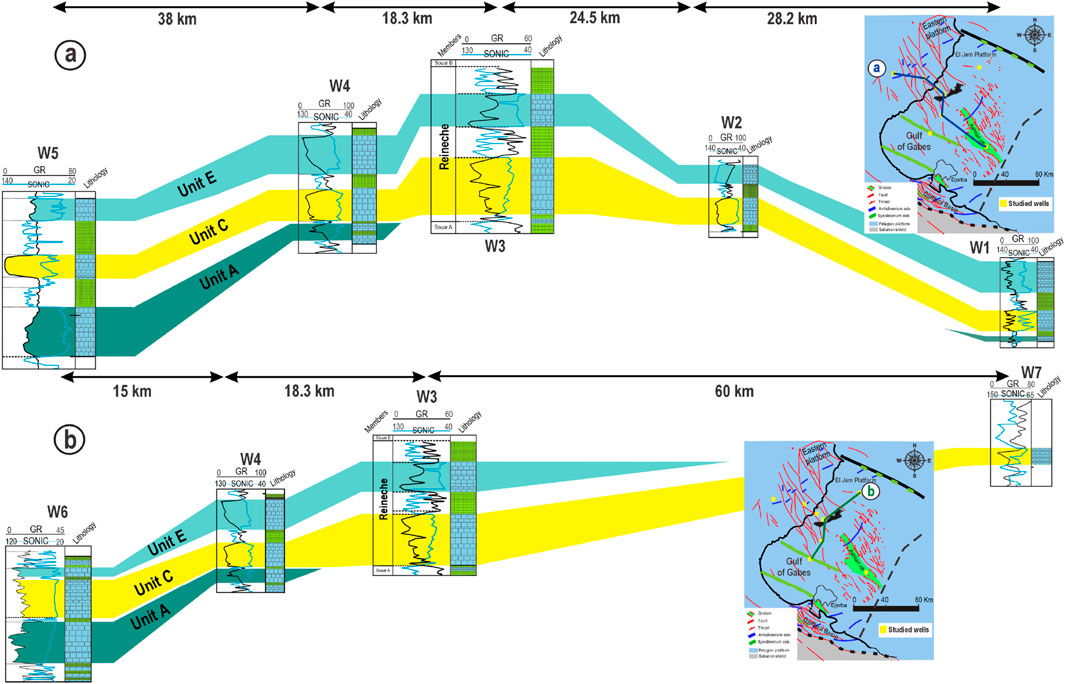
Figure 12. Evolution of Reineche Member units from NW to SE (A) and SW to NE (B) in the Gulf of Gabes.
From SE to NW, bioclastic limestones and changes laterally to clays of the Souar A formation in the Cercina area represent Unit A. The thickness of this unit decreases considerably in the NW.
Significant variations in thickness also characterize the clay of unit B. This unit is absent in the NW (zone 2, near Sfax onshore). The thickness of unit B varies considerably from one well to the next. It decreases sharply to the NW of Ashtart and is absent in the Cercina field.
Unit C, identified everywhere, consists of large nummulites to nummulithoclasts limestones, clays, and bioclastic limestones 23 m thick. These limestones later change to chalky limestones in the NE. Towards the SE and NW, Unit C changes to bioclastic lumachellic limestones with clays and limestones with small Nummulites. The thickness of these limestones decreases towards the SE, reaching 10 m at the SE and 12 m at the S.
All wells intersect the argillaceous Unit D except in the NE, where solely the limestone of Unit C represents the Reineche Member (W7, Figure 12). It is 12 m thick at Cercina. It decreases towards the NW, reaching 8 m at Sfax onshore. Towards the SE, unit D becomes thicker, reaching 16 m at the extreme SE, then decreasing considerably at the south (W6, 0.5 m).
Unit E, formed by bioclastic limestones with bivalves and gastropods at the top of the Reineche Member, is 14 m thick and decreases to the SE, where it is up to 6 m at the south and 13 m in Sfax onshore. This unit transitions to clays of the Souar B Formation to the NE.
Two lithostratigraphic correlations were carried out between the Gulf of Gabes and Sahel wells to highlight the different variations in thickness and facies. The first correlation crosses W1 to W5 (Section 1). The latter is oriented NW-SE. The second crosses the W3, W4, W6, and W7 (Section 2), trending NE-SW (Figure 12).
From the wells studied and the correlations made, we can highlight three zones of distribution of the Reineche member oriented along the same NW-SE direction (Figure 13).
1.Meridionale zone (zone 1): located in the south and characterized by the presence of three carbonate units (A, C, and E) separated by clays (B and D).
2.Middle zone (zone 2): This centrally located zone encompasses the wells where the Reineche Member is in the form of two carbonate units (C and E), separated by the clays of unit D. This zone includes the Siouf outcrop in central Tunisia.
3.Septentrionale zone (zone 3): Located to the east and northeast, the Reineche Member is represented by a single, very thin carbonate unit, which may be equivalent to the entire Unit C or the URL unit.
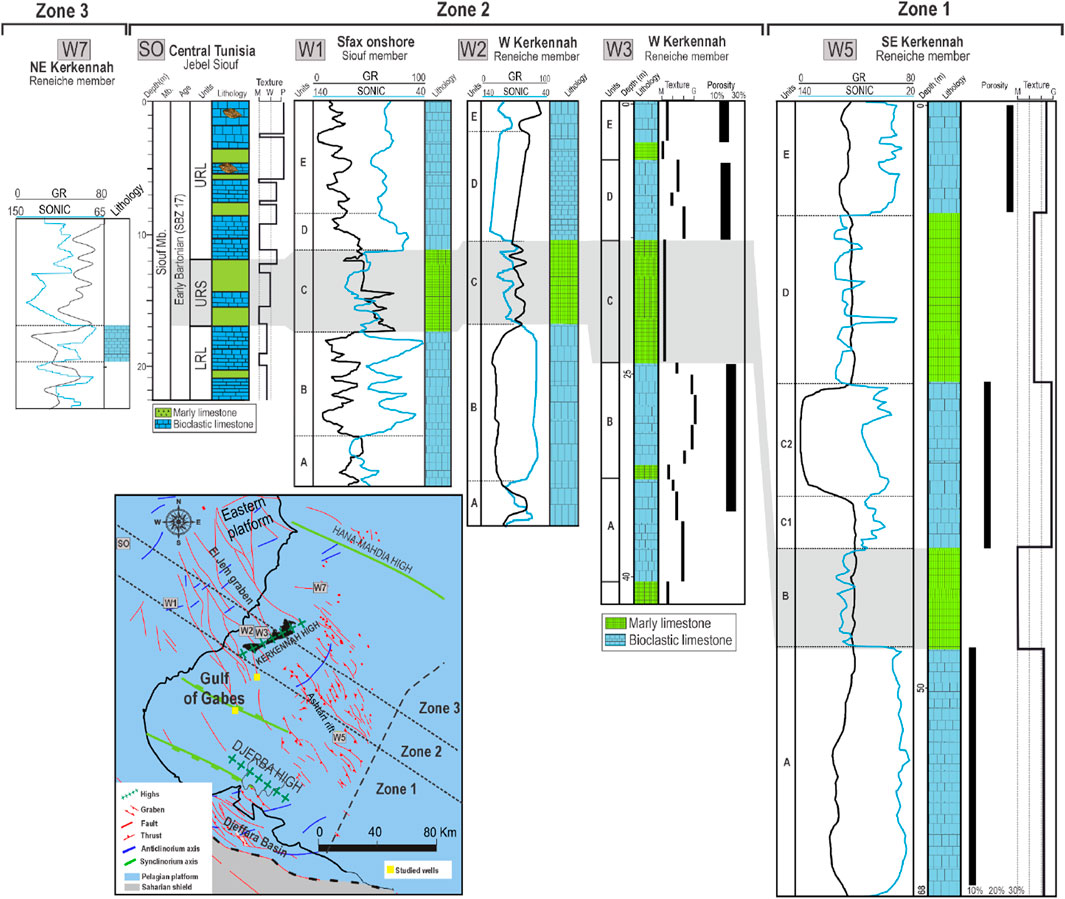
Figure 13. Distribution of the Reineche member units in the northern Gulf of Gabes in the Siouf outcrop (SO) and five wells in eastern Tunisia.
The distribution of the different units of the Reineche member is related to the specific depositional conditions of each environment. In the median zone where the Cercina field exists, the Reineche comprises three units, of which the well-developed Unit C is characterized by its richness in large Nummulites with a dominant grainstone texture. These Nummulites form a band or barrier to bioaccumulation associated with other organisms. These bioaccumulations developed on relatively high areas on the edges of the dominant NW-SE normal faults in the Gulf of Gabes. To the SW of this barrier, a southern zone is characterized by a confined sedimentation (Miliolids) dominated by lumachellic and bioclastic carbonates and a benthic fauna (small Nummulites, bivalves, Gastropods, Echinoid). These carbonate microfacies are characterized by a texture that changes from wackestone to packstone and grainstone. This zone corresponds to an internal platform-type sedimentation.
To the northeast of this barrier, a vast zone is represented by an increasing richness of clays and chalky limestone and a richness of foraminifera and chalky limestone and richer in planktonic foraminifera, with the disappearance of large and small Nummulites (outer shelf setting). This reservoir is covered by the overlying clays of the Souar B Formation (up to 400 m of clays). The traps are both structural and stratigraphic. Faults around the Kerkenah archipelago control the deposition of Nummulites bodies. The migration paths would have been through the fault planes. These would have enabled the transfer of hydrocarbons from possible source rocks (Bou Dabbous Formation and Bahloul Formation). In Sfax onshore, the total thickness of the Reineche member is 40 m with a clear distinction of three units in the GR log. Here, the URL is 15 m thick and rich in nummulites. The Reineche member shows important thickness changes from 19 to 40 m and reaches up to 70 m to the E and SE (Figure 12). The nummulitic URL unit is characterized by significant thickness variations and may be found very thin or absent (toward the N and NE). The structuring of the Sfax offshore region is controlled by active distensive tectonics, with frequent NW-SE faults and normal NE-SW faults. The interference of these two families of faults divides the region into blocks, responsible for variations in the facies and thickness of the Reineche member, particularly for the URL nummulitic unit.
5.5 Diagenesis and reservoir porosity
Micritization, cementation, neomorphism, and intense dissolution are the main diagenetic processes that affected the Siouf Member (Figure 14) in central Tunisia. Due to the varied depositional environment and post-deposition diagenesis, the Reineche member in the Sfax offshore has a distinct diagenetic process from the Siouf Member. The bioclasts edge micritization has been reported primarily on facies F1, F2, and F3. Facies F4 and F5 show lesser micritization and are more related to the matrix than the bioclasts. Micritization is more prevalent in bioclastic and wackestone facies in restricted inner and central lagoon. Boring by microbes is assumed to be the most pervasive source of micritization, with most cases occurring in shallow lagoonal environments (Bey et al., 2015; Jorry, 2004).
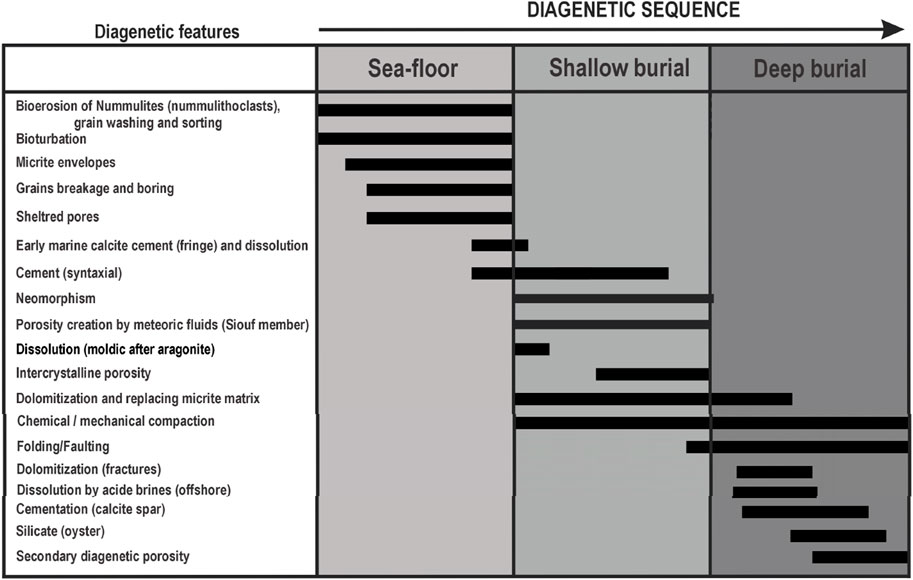
Figure 14. Chronology of the diagenetic features observed in Siouf/Reineche Member. Dissolution conditions separate at least three distinct cement precipitation events. Two generations of fractures are observed. Secondary porosity, the second generation of fractures, and the vuggy porosity occurred from the Oligocene to early Miocene.
Dissolution occurs through the entire Siouf Member and is more intense in the LRL and the lower part of the URL. At the outcrop, the dissolution products are a variety of vugs of different sizes and shapes. Inner lagoon facies (F1, F2, and F3) show complete leaching of the bioclasts, in contrast to facies F4 and F5, where a moderate dissolution affects both the matrix and the bioclasts. Dissolution follows the zones affected by recrystallization, the matrix of the packstone facies, and the nummulithoclasts (Bey et al., 2015). The ensuing porosity results from brief sub-aerial exposures promoting freshwater leaching. The precipitation of dolomite consists of the replacement of carbonate mud by euhedral dolomite crystals (Njahi et al., 2017; Yaich, 1984).
The precipitation of block-shaped cement is mainly generated in meteoric phreatic diagenetic settings (Njahi et al., 2017; Figure 14). Meteoric fluids increase the spreading of granular calcite cement in skeletal and non-skeletal grains, forming granular cement (Figure 8). The uniform tiny crystals in the meteoric phreatic zone distinguish this cement. Early burial cementation in the Siouf Member leads to granular cement filling intraparticle pores (Figure 8).
Diagenetic processes primarily govern the origin and type of porosity in the Siouf Member during the early near surface and shallow burial phases (Figure 14). Primary porosity is effective (Figure 15), with inter-particle/intra-particle nature, whereas secondary porosity comprises inter-crystalline and dissolution forms. The massive dissolution observed in the Siouf Member is due to the subaerial-derived meteoric water. This is not the case for the distal Reineche member (offshore Tunisia) where the dissolution took place during burial diagenesis by acid brines (CO2-rich fluids) after the shallow burial recrystallization and dolomitization as proposed by for El Garia reservoir of offshore Tunisia (Beavington-Penney et al., 2008; Racey et al., 2001).
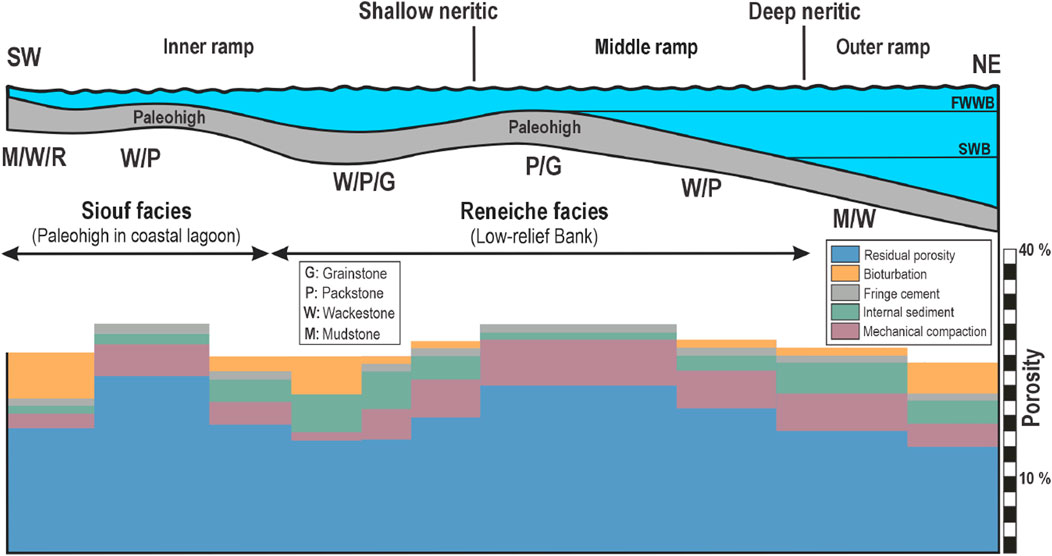
Figure 15. Proximal-distal transect showing the lateral evolution of the primary porosity along the complex ramp (lagoon and low relief carbonate bank).
Primary porosity is limited in the Siouf Member (inter-particle and intra-particle types), with limited inter-crystalline porosity in tightly packed packstone. The dissolution type porosity is common within the grainy facies. Intense dissolution and dolomitization enhance the reservoir quality with up to 30% porosity near the Kerkenah archipelago (Figure 15). Secondary porosity, developed post-deposition, includes intercrystalline porosity from early shallow burial diagenesis (neomorphism or dolomitization) and dissolution porosity from late burial diagenesis, particularly in former dolomitized zones. Small irregular vugs are common in the micritic matrix. Fracture porosity is often reduced or occluded by late-stage drusy calcite spar. Extensive dissolution of the Reineche nummulitic limestones in the eastern Tunisian offshore occurred during burial diagenesis due to aggressive CO2-rich fluids as in the case of the Early Eocene El Garia Formation in the Gulf of Gabes (Beavington-Penney et al., 2008; Racey et al., 2001).
In central and eastern onshore Tunisia, the Reneiche Member is comprised of three carbonate units: the Lower Reneiche Nummulitic Limestone, the Upper Reneiche Nummulitic Limestone, and the Upper Reneiche Shale unit that separates the two. Offshore in eastern Tunisia, Gamma-Ray and Sonic data have revealed three distinct limestone reservoir layers (A, C, and E), interspersed with two shale units. Secondary porosity, primarily inter-crystalline and dissolution types, is most prevalent. Generally, porosity decreases in the back bank facies, except for the Siouf Member, where meteoric and shallow burial diagenesis have resulted in good porosity. The basal Cherahil (B) Formation acts as the seal for the Reneiche/Siouf reservoir. The NW-SE trending bank facies is considered to have a high probability of good reservoir quality further enhanced by fracturing and dissolution.
6 Conclusion
Our integrated surface-subsurface study focuses on characterizing the Early Bartonian nummulitic reservoir zonation within the Siouf/Reineche Member. By combining fieldwork and subsurface data, the study provides insights into the sedimentology (carbonate units geometry), depositional settings, sequence stratigraphy, and diagenesis of these carbonate units. The conclusions from this study and its wider implications are outlined below:
6.1 Carbonate deposition
The lagoonal deposition of the Siouf Member is shaped by storms and tidal currents within a low-angle homoclinal ramp, featuring lagoons and low-relief carbonate banks. The fossil assemblage is dominated by non-framework organisms such as oysters, gastropods, solitary algae, and green algae, with intense biomoldic porosity and dolomitization enhancing reservoir qualities. The multi-scale heterogeneity in the Siouf/Reineche reservoirs in central and eastern Tunisia is significantly influenced by depositional factors such as hydrodynamics and the balance between carbonate factory productivity and accommodation space. These factors affect lateral facies migration and create complex depositional patterns. We show how addressing small-scale reservoir heterogeneities and associated geological factors in greater detail is crucial for defining conceptual geological models.
6.2 Reservoir units
The lagoon limestones of the Siouf Member shows intense biomoldic porosity and dolomitization enhancing the reservoir qualities. In the more distal settings (Reneiche member, northern Gulf of Gabes) the most favorable area for reservoir development is tied to the nummulitic-nummulithoclastic pack/grainstone facies of the high energy bank and the facies of the back bank. In the southern Kerkenah archipelago, the Reineche member is thicker with three limestone units (A, C, and E) separated by two clay units (B and D), where locale tectonics affect the thickness these units. Bioclastic limestones with Bivalves, and echinoids, represent Unit A and benthic foraminifera characterizing the SW zone (Sfax onshore). Unit C consists of Nummulites limestone near the Kerkenah archipelago (Zone 2), gradually becoming bioclastic to the West. Unit E corresponds to lumachellic limestones. Facies transition from carbonate-dominated facies in the south, with three limestone units, to predominantly clay facies in the east and northeast (Zone 3). The Reineche Limestone Member is dominated by large nummulites (with high porosity, Zone 2) deposited within the nummulites barrier. Despite limited data, our results provide valuable insights into the storage potential of the early Bartonian tight nummulitic limestone, which could serve as a key CO2 storage unit in the eastern Tunisian offshore, with thick intercalated shale units acting as potential seals in the Gulf of Gabes.
Based on petrographic studies, field observations, and analysis of microfacies and bathymetric shifts, the Siouf member is divided into three sequences that reflect deepening upwards trends. The boundaries between these intervals are defined at the base of the most proximal facies, which are followed by shallowing trends. Our study highlights the importance of tectonic influences and sea level changes in shaping the reservoir thickness and quality mainly related to the nummulitic facies.
Data availability statement
The raw data supporting the conclusions of this article will be made available by the authors, without undue reservation.
Author contributions
JHM: Conceptualization, Data curation, Formal Analysis, Funding acquisition, Investigation, Methodology, Project administration, Resources, Software, Supervision, Validation, Visualization, Writing–original draft, Writing–review and editing. NT: Supervision, Writing–review and editing. BB: Formal Analysis, Writing–review and editing. TA: Conceptualization, Methodology, Writing–review and editing. MA: Investigation, Methodology, Writing–review and editing. CY: Supervision, Writing–review and editing.
Funding
The author(s) declare that financial support was received for the research, authorship, and/or publication of this article. Financial support for this work was provided by the University of Copenhagen, funding JHM’s PhD project, including his stay in Denmark and fieldwork. King Abdullah University of Science and Technology (KAUST) in Saudi Arabia financed the laboratory analysis and supplied the necessary equipment for this research.
Acknowledgments
We would like to express our sincere gratitude to King Abdullah University of Science and Technology (KAUST) for providing the financial support and equipment necessary to conduct this research. Their generous contributions were essential to the success of this work. We are also deeply appreciative of the reviewers, whose valuable feedback has greatly improved the quality of this paper. Finally, we extend our heartfelt thanks to Professor Valerio Acocella for his constructive comments and guidance, which have been instrumental in refining our work.
Conflict of interest
The authors declare that the research was conducted in the absence of any commercial or financial relationships that could be construed as a potential conflict of interest.
Publisher’s note
All claims expressed in this article are solely those of the authors and do not necessarily represent those of their affiliated organizations, or those of the publisher, the editors and the reviewers. Any product that may be evaluated in this article, or claim that may be made by its manufacturer, is not guaranteed or endorsed by the publisher.
Supplementary material
The Supplementary Material for this article can be found online at: https://www.frontiersin.org/articles/10.3389/feart.2024.1452977/full#supplementary-material
References
Bassi, D., Nebelsick, J. H., Puga-Bernabéu, Á., and Luciani, V. (2013). Middle Eocene Nummulites and their offshore re-deposition: a case study from the Middle Eocene of the Venetian area, northeastern Italy. Sediment. Geol. 297, 1–15. doi:10.1016/j.sedgeo.2013.08.012
Baz, S. M.El (2019). Middle Eocene larger benthic foraminifera from Egypt and their similarity to the southern tethyan provinces. J. Afr. Earth Sci. 152, 95–100. doi:10.1016/j.jafrearsci.2019.02.001
Beavington-Penney, S. J., Nadin, P., Wright, V. P., Clarke, E., McQuilken, J., and Bailey, H. W. (2008). Reservoir quality variation on an Eocene carbonate ramp, El Garia Formation, offshore Tunisia: structural control of burial corrosion and dolomitisation. Sediment. Geol. 209, 42–57. doi:10.1016/j.sedgeo.2008.06.006
Ben-Ismail-Lattrache, K. (2000). Precision on Lutetian-Bartonian passage of middle Eocene deposits in central and north-eastern Tunisia. Rev. Micropaléontologie 43, 3–16. doi:10.1016/S0035-1598(00)90060-6
Bey, S., Alaya, S. B., and Jemia, H. F. B. (2015). Integrated CMR, FMI and facies analyses to assess porosity types and distribution of the Middle Eocene limestones - case study of gas reservoir, Pelagean sea. Tunis. Soc. Petroleum Eng. - SPE North Afr. Tech. Conf. Exhib. 2015, NATC 2015, 808–825. doi:10.2118/175795-ms
Bonnefous, J., and Bismuth, H. (1982). Les faciès carbonatées de la plateforme de l’Eocène moyen et supérieur dans l’offshore Tunisien Nord-oriental et en mer pélagienne: implications paléogéographiques et analyses micropaléontologique. Bull. Centr. Rech. Explor. Pro. ELF Aquitaine 6, 337–403.
Brasier, M. D. (1995). Fossil indicators of nutrient levels. 2: evolution and extinction in relation to oligotrophy. Mar. Palaeoenvironmental Analysis Fossils 83 (1), 133–150. doi:10.1144/GSL.SP.1995.083.01.08
Burollet, P. F. (1956). Contribution à l’étude stratigraphique de la Tunisie centrale. Ann. Mines geol., Tunis 18.
Chouat, S., Ayachi, M. S.El, Boukhalfa, K., Alouani, R., Soussi, M., and Boughdiri, M. (2023). Biofacies analysis and depositional environments of mid-Eocene larger benthic foraminifera-rich deposits in northern Tunisia. Carbonates Evaporites 38, 65. doi:10.1007/s13146-023-00888-4
Dunham, R. J. (1962). Classification of carbonate rocks according to depositional texture. AAPG Mem., 108–121.
Elfessi, M. (2017). New insights into the stratigraphic, paleogeographic and tectonic evolution and petroleum potential of Kerkennah Islands, Eastern Tunisia. J. Afr. Earth Sci. 125, 88–102. doi:10.1016/j.jafrearsci.2016.10.015
Ferjani, A. B., Burrollet, P. F., and Mejri, F. (1990). Petroleum geology of Tunisia. Mém. ETAP, Tunis. n°1 194.
Flugel, E., and Flügel, E. (2004). Microfacies of carbonate rocks, analysis, interpretation and application. Berlin: Springer-Verlag, 976.
Göttlich, K., Rodriguez, J., Mnii, S., Mzoughi, W., Lovett., T., and Tari, G. (2023). “Petroleum system evaluation of upper cretaceous and eocene plays, offshore and onshore southern pelagian basin, Tunisia,” in Regional Geology reviews Geology of north Africa and the mediterranean: sedimentary basins and georesources. Editors S. Khomsi, and F. Roure (Springer, Cham: Springer), 105–142.
Guo, X., Feng, J., Wang, P., Kong, B., Wang, L., Dong, X., et al. (2023). Review on the mechanism of CO2 storage and enhanced gas recovery in carbonate sour gas reservoir. Processes 11, 164. doi:10.3390/pr11010164
Hamdi, A. A., and Lattrache, K. B. I. (2013). Middle to upper Eocene ostracods and associated foraminifera of the Jebel Serj section (central Tunisia). Biostratigraphical, paleoecological and paleobiogeographical significance. Rev. Micropaléontologie 56, 159–174. doi:10.1016/j.revmic.2013.10.002
Höntzsch, S. (2011). Palaeogene carbonate platforms under climatic and tectonic stress – case studies from Egypt and Spain. Bremen (Germany): University of Bremen. PhD thesis.
Höntzsch, S., Scheibner, C., Brock, J. P., and Kuss, J. (2013). Circum-Tethyan carbonate platform evolution during the Palaeogene: the Prebetic platform as a test for climatically controlled facies shifts. Turkish J. Earth Sci. 22, 891–918. doi:10.3906/yer-1207-8
Jemia-Fakhfakh, H. B. (1991) “Les calcaires de l’Eocène inférieur en Tunisie centro-septentrionale: sédimentologie, paléogéographie,” Franche-comté (France): Thèse Doct. d’Univ.
Jorry, S. (2004). The eocene nummulite carbonates (Central Tunisia and NE Libya): sedimentology, depositional environments, and application to oil reservoirs. Sci. la Terre Genève.
Kadri, A., Essid, E. M., and Merzeraud, G. (2015). “Kasserine island” boundaries variations during the upper cretaceous-eocene (central Tunisia). J. Afr. Earth Sci. 111, 244–257. doi:10.1016/j.jafrearsci.2015.07.027
Khomsi, S., Bédir, M., Soussi, M., Jemia, M. G. B., and Ismail-Lattrache, K. B. (2006). Mise en évidence en subsurface d'événements compressifs Éocène moyen–supérieur en Tunisie orientale (Sahel): généralité de la phase atlasique en Afrique du Nord. Comptes Rendus - Geosci. 338, 41–49. doi:10.1016/j.crte.2005.11.001
Liu, X., Zhang, F., Song, S., Tan, X., and Feng, G. (2024). The feasibility of heat extraction using CO2 in the carbonate reservoir in shandong province, China. Energies (Basel) 17, 2910. doi:10.3390/en17122910
Liu, Y., Huang, Z., Wang, Y., Wang, W., and Wang, J. (2021). Thermo-hydro-mechanical coupling processes in carbonate geothermal reservoirs and their numerical simulation. Lithosphere 2021. doi:10.2113/2022/9466388
Matmati, M. F., M’Rabet, A., and Ismail, K. B. (1992). Etude sédimentologique et paleogeographique des facies carbonates et evaporitiques de l’Eocene inferieur dans la region de Faid- Nara et Lassonda (Tunisie centrale). Note Serv. Geol. Tunis. 58, 29–42.
Mejri, F., Burollet, P. F., and Ferjani, A. B. (2009). Petroleum geology of Tunisia, A renewed Synthesis. Entrep. Tunis. Des. Act. Pétrolières.
Messaoud, H. J., Thibault, N., Aljahdali, M. H., and Yaich, C. (2023). Middle Eocene to early Oligocene biostratigraphy in the SW Neo-Tethys (Tunisia): large-scale correlations using calcareous nannofossil events and paleoceanographic implications. J. Afr. Earth Sci. 198, 104805. doi:10.1016/J.JAFREARSCI.2022.104805
Messaoud, J. H., Thibault, N., Aljahdali, M. H., Yaich, C., and Gu, Y. G. (2024). Calcareous nannoplankton response to middle-late Eocene climate and sea-level changes in the SW Neo-Tethys. Mar. Micropaleontol. 187, 102329. doi:10.1016/J.MARMICRO.2023.102329
Messaoud, J. H., Thibault, N., Bomou, B., Adatte, T., Monkenbusch, J., Spangenberg, J. E., et al. (2021). Integrated stratigraphy of the middle-upper eocene Souar Formation (Tunisian dorsal): implications for the middle eocene climatic Optimum (MECO) in the SW neo-tethys. Palaeogeogr. Palaeoclimatol. Palaeoecol. 581, 110639. doi:10.1016/J.PALAEO.2021.110639
Messaoud, J. H., Thibault, N., De Vleeschouwer, D., and Monkenbusch, J. (2023). Benthic biota (nummulites) response to a hyperthermal event: eccentricity-modulated precession control on climate during the middle Eocene warming in the Southern Mediterranean. Palaeogeogr. Palaeoclimatol. Palaeoecol. 626, 111712. doi:10.1016/j.palaeo.2023.111712
Miller, K. G., Browning, J. V., Schmelz, W. J., Kopp, R. E., Mountain, G. S., and Wright, J. D. (2020). Cenozoic sea-level and cryospheric evolution from deep-sea geochemical and continental margin records. Sci. Adv. 6, eaaz1346. doi:10.1126/sciadv.aaz1346
Njahi, Z., Kassabi, N., and Touir, J. (2017). Porosity and reservoir potentiality of the Cherahil Formation limestone (middle-upper eocene) in the gulf of Gabes (Tunisia). J. Afr. Earth Sci. 131, 166–178. doi:10.1016/j.jafrearsci.2017.04.009
Prothero, D. R., Ivany, L. C., and Nesbitt, E. A. (2003). From greenhouse to icehouse: the marine Eocene–Oligocene transition. New York: Columbia Univ. Press, 541.
Racey, A., Bailey, H. W., Beckett, D., Gallagher, L. T., Hampton, M. J., and McQuilken, J. (2001). The petroleum geology of the early eocene el garia formation, Hasdrubal field offshore Tunisia. J. Petroleum Geol. 24, 29–53. doi:10.1111/j.1747-5457.2001.tb00660.x
Raza, A., Gholami, R., Rezaee, R., Han Bing, C., Nagarajan, R., and Ali Hamid, M. (2017). Preliminary assessments of CO2 storage in carbonate formations: a case study from Malaysia. J. Geophys. Eng. 14, 533–554. doi:10.1088/1742-2140/aa5e71
Rotelli, F., Blunt, M. J., De Simoni, M., Dovera, L., Rotondi, M., and Lamberti, A. (2017). “CO2 injection in carbonate reservoirs: combining EOR and CO2 storage,” in Offshore Mediterranean Conference and Exhibition, Ravenna, Italy, March 29, 2017.
Scheibner, C., and Speijer, R. P. (2009). Recalibration of the shallow-benthic zonation across the Paleocene-Eocene boundary: the Egyptian record. Geol. Acta, 195–214.
Sebei, K., Inoubli, M. H., Boussiga, H., Tlig, S., Alouani, R., and Boujamaoui, M. (2007). Seismic stratigraphy, tectonics and depositional history in the Halk el Menzel region, NE Tunisia. J. Afr. Earth Sci. 47, 9–29. doi:10.1016/j.jafrearsci.2006.09.002
Singh, M., Mahmoodpour, S., Schmidt-Hattenberger, C., Sass, I., and Drews, M. (2024). Influence of reservoir heterogeneity on simultaneous geothermal energy extraction and CO2 storage. Sustain. Switz. 16, 387. doi:10.3390/su16010387
Swei, G. H., and Tucker, M. E. (2015). Hydrocarbon potential of middle eocene carbonates, Sirt Basin, Libya. J. Afr. Earth Sci. 111, 363–374. doi:10.1016/j.jafrearsci.2015.07.009
Taktak, F., Bouaziz, S., and Tlig, S. (2012). Depositional and tectonic constraints for hydrocarbon targets of the Lutetian-Langhian sequences from the Gulf of Gabes - Tunisia. J. Pet. Sci. Eng. 82 (83), 50–65. doi:10.1016/j.petrol.2011.11.004
Taktak, F., Kharbachi, S., Bouaziz, S., and Tlig, S. (2010). Basin dynamics and petroleum potential of the Eocene series in the gulf of Gabes, Tunisia. J. Pet. Sci. Eng. 75, 114–128. doi:10.1016/j.petrol.2010.10.010
Tlig, S., Sahli, S., Er-Raioui, L., Alouani, R., and Mzoughi, M. (2010). Depositional environment controls on petroleum potential of the Eocene in the North of Tunisia. J. Pet. Sci. Eng. 71, 91–105. doi:10.1016/j.petrol.2010.01.009
Tomassetti, L., Benedetti, A., and Brandano, M. (2016). Middle Eocene seagrass facies from Apennine carbonate platforms (Italy). Sediment. Geol. 335, 136–149. doi:10.1016/j.sedgeo.2016.02.002
Wawerzinek, B., Buness, H., von Hartmann, H., and Tanner, D. C. (2021). S-wave experiments for the exploration of a deep geothermal carbonate reservoir in the German Molasse Basin. Geotherm. Energy 9, 6. doi:10.1186/s40517-021-00189-w
Wu, Y., and Li, P. (2020). The potential of coupled carbon storage and geothermal extraction in a CO2-enhanced geothermal system: a review. Geotherm. Energy 8, 19. doi:10.1186/s40517-020-00173-w
Keywords: Gamma-ray, Nummulite-rich limestone, carbonate diagenesis, reservoir characterization, carbonate porosity
Citation: Haj Messaoud J, Thibault N, Bomou B, Adatte T, Aljahdali MH and Yaich C (2024) Integrated surface-subsurface reservoir zonation of the early Bartonian nummulitic limestone in central Tunisia and eastern Tunisian offshore. Front. Earth Sci. 12:1452977. doi: 10.3389/feart.2024.1452977
Received: 21 June 2024; Accepted: 21 August 2024;
Published: 13 September 2024.
Edited by:
George Kontakiotis, National and Kapodistrian University of Athens, GreeceReviewed by:
Salman Khattak, Chinese Academy of Sciences (CAS), ChinaBilal Wadood, University of Swabi, Pakistan
Copyright © 2024 Haj Messaoud, Thibault, Bomou, Adatte, Aljahdali and Yaich. This is an open-access article distributed under the terms of the Creative Commons Attribution License (CC BY). The use, distribution or reproduction in other forums is permitted, provided the original author(s) and the copyright owner(s) are credited and that the original publication in this journal is cited, in accordance with accepted academic practice. No use, distribution or reproduction is permitted which does not comply with these terms.
*Correspondence: Jihede Haj Messaoud, amloZWRlLmhham1lc3Nhb3VkQGthdXN0LmVkdS5zYQ==
 Jihede Haj Messaoud
Jihede Haj Messaoud Nicolas Thibault
Nicolas Thibault Brahimsamba Bomou3
Brahimsamba Bomou3 Thierry Adatte
Thierry Adatte Mohammed H. Aljahdali
Mohammed H. Aljahdali Chokri Yaich
Chokri Yaich